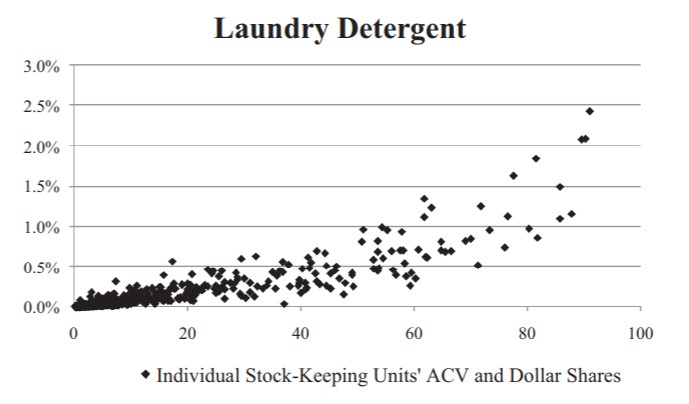An interesting question in marketing concerns the distribution that any particular SKU (Stock Keeping Unit) will receive. Generally, more distribution is better. Distribution simply allows more people the opportunity to buy your product. As such managers will fight for distribution. What then do we know about the relationship between SKUs, market share and distribution?
Distribution And Market Share
We can expect distribution to follow market share. This makes sense. The logic is that higher market share means a higher percentage of people will buy it. (Technically percentage of purchased volume or revenue but thinking people is simpler). If a lot will buy the product then retailers have an incentive to stock it. Clearly, the causal link isn’t perfectly one way. A lot of retailers stocking a SKU will generally generate greater sales. This links to higher market share. Whereas if retailers don’t stock your product it probably won’t sell much. Distribution leads to sales and vice versa.
SKUs, Market Share And Distribution
Kenneth Wilbur and Paul Farris (my professor at Darden) analyzed the relationship between market share and distribution. They found that “the relationship between market share and retail distribution is increasing and convex at the SKU level”. (Wilbur and Farris, 2014, page 154). In essence, as expected share tends to be associated with high distribution and this works at a SKU level. (Not just at a brand or a company level). The convexity is that having a high share increasingly helps. More share gives a disproportionate increase to distribution.

Managerial Assumptions
One of the most fascinating discussions revolves around the role of distributional assumptions in planning. The authors use distributional assumptions to help understand why SKU launches fail so often. They suggest it might be managers making overly ambitious distributional assumptions in order to get the SKUs they are personally invested in launched.
The easiest way to ensure a new SKU will be introduced is to overestimate the number of stores that will sell it.
Wilbur and Farris, 2014, page 161
Distribution is an important topic for marketers. It is great to have an improved understanding of its associations.
For more on distribution see here and here.
Read: Kenneth C. Wilbur and Paul W. Farris (2014) Distribution and Market Share, Journal of Retailing 90 (2) pages 154-167
